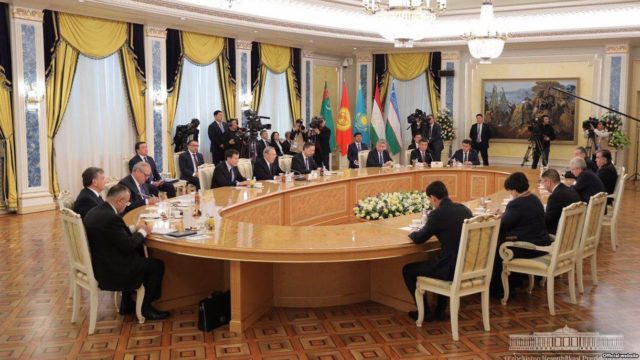
Central Asia Ready to Move on Without Russia
Publication: Eurasia Daily Monitor Volume: 15 Issue: 42
By:

Since becoming independent in 1991, the countries of Central Asia, both individually and collectively, have been viewed by many outsiders and even some of their own people as the inevitable objects of politics rather than as potential subjects. The region is widely considered one of international competition among Russia, the United States and China. But now, two tectonic shifts in Central Asia as well as key changes in the international environment are calling that vision into question. For the first time ever, these five post-Soviet republics are seeking to work together and without outside interference in order to defend and promote their own interests.
Two major changes in the region are critical to understanding what is happening there. First, Shavkat Mirziyoyev, the new president of Uzbekistan, who heads the largest and potentially dominant state in the area, has taken a new approach. Specifically, he has sought cooperation rather than conflict with his neighbors (see EDM, September 18, 2017; January 17, 2018; March 12, 2018), which is significantly reducing the kinds of intra-regional conflicts outsiders had long exploited. Second, Kazakhstan, also for the first time, is playing as a Central Asian country rather than as an outlier between that region and Russia.
It is worth recalling that in Soviet times, Moscow always referred to the region as “Central Asia and Kazakhstan.” That terminology reflected the longstanding Russian policy of divide and rule: Kazakhstan could not be a Central Asian country except at the risk of losing its ethnically Russian north; and Central Asia could not unite unless Kazakhstan was part of it and served as a counterweight to Uzbekistan’s power. Now, however, the ethnic-Russian share of Kazakhstan’s population has fallen from a plurality to less than a quarter. And Nursultan Nazarbayev, as he ages, increasingly seeks to put his country on track to be a powerful, independent and Kazakh-centric state—one with a Latin script rather than a Russian one (see EDM, April 25, 2017; March 5, 2018) and displacing Russia as a transport hub between Europe and Asia (see EDM, January 14, 2014; May 20, 2015; November 17, 2017). Therefore, Moscow’s old calculation that it could continue to dictate that Kazakhstan is not a part of the rest of Central Asia—a notion that was often accepted by both the West and China—has collapsed.
Those two developments further coincide with changes in the broader international environment. China continues to pursue investment and influence in Central Asia, especially in Kyrgyzstan and Tajikistan; but Russia, because of its crisis, and the United States, because of its own concerns, are devoting far less attention to the region and its countries than they did earlier. Moscow largely assumes that this landlocked region, with all its problems, including a burgeoning population, security threats from Afghanistan and Islamist movements, and the continuing need for transfer payments from guest workers in the Russian Federation, will ultimately come back into Russia’s orbit. While Washington’s mindset appears to be that the region is far from the United States and its current “America first” policies.
Last week, for the first time since 2005, the leaders of the five countries—four presidents and the head of Turkmenistan’s parliament—met in Astana to discuss cooperation and integration. The tone of the meeting was set by its host, Kazakhstani President Nursultan Nazarbayev, who declared that “in order to solve the problems of Central Asia, we do not need any third persons. We ourselves can resolve all questions, and that is why we are meeting” (Turan Today, March 15).
Nazarbayev and his colleagues were careful not to name the outsiders—Moscow, Washington and Beijing—on whom they no longer want to be dependent. And it is unlikely that any of the five Central Asian regimes can break away cleanly from all three or any one of them anytime soon: geography, history and culture work against that. But the meeting and the Kazakhstani president’s declaration represent a likely turning point for the region. As such, they challenge not only the outside powers but the five regional countries themselves to find new ways for a modus vivendi. And Nazarbayev made clear that all this was happening primarily because of what the new president of Uzbekistan has been doing.
“In the course of a single year, from March of last year, all the presidents of the region have conducted bilateral meetings.” As Nazarbayev stressed, the result of “the enormous work” by Uzbekistan’s Mirziyoyev has been to “[unfreeze] many of the problems that have built up over the last 20 years.” Moreover, the Kazakhstani head of state praised Mirziyoyev for coming up with the idea of having the meeting in Astana itself (Uzbekistan’s president proposed doing so last September, during the session of the United Nations General Assembly). In recent months, Central Asian officials have been exploring how to achieve this goal. Now it has happened, sparking apprehension in Moscow. Russian authorities view this as yet another attempt by these former Soviet states to exit the post-Soviet space. And they blame the West and China for this growing trend, even as some in Beijing and even Washington are concerned about the meaning for them of a common Central Asian “front” (RBC, March 15).
At the close of the summit, the five Central Asian leaders announced that they would convene again in Tashkent a year from now and in the intervening period would create a five-sided working commission, at the deputy prime minister level, to support cooperation. Obviously, such meetings by themselves will not change everything: they cannot trump geography or history. But this type of cooperation means that there will increasingly be a new player on the board in this region, one Moscow, Beijing and Washington will all have to take into consideration.



